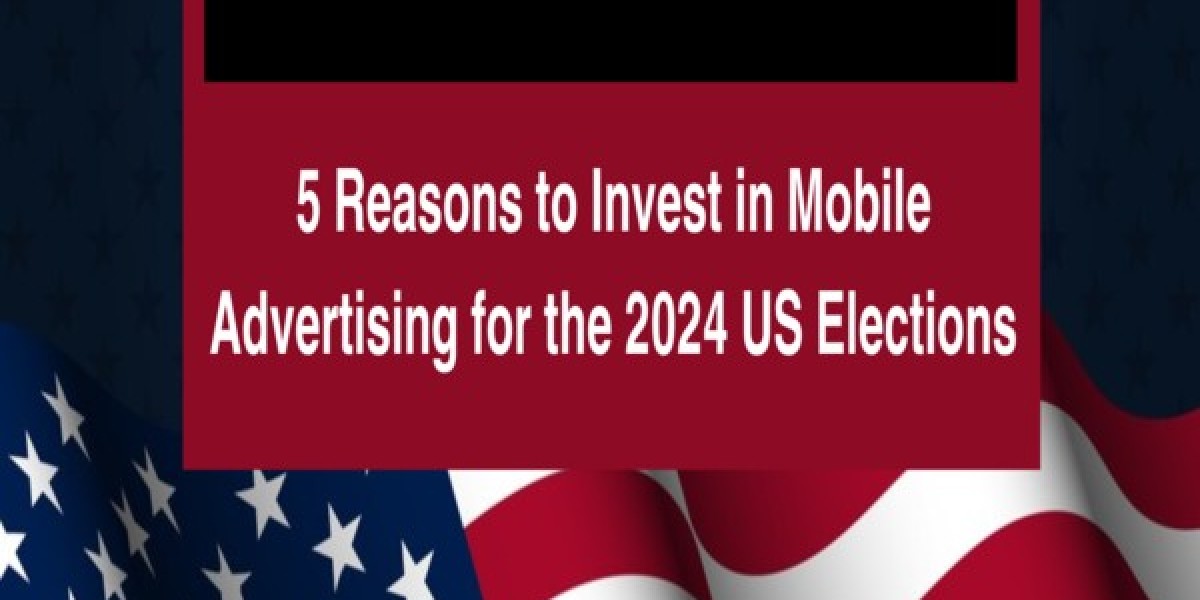In the fast-evolving world of political campaigns, mobile advertising plays a crucial role in shaping the outcome of elections. The US elections 2024 are no exception, with political advertising spending projected to reach an unprecedented USD 10.2 billion—marking a significant increase from the USD 9 billion spent during the 2022 midterms. Political ad revenue in the United States is forecast to grow exponentially over the next few years, from USD 2.5 billion in 2021 to USD 15.2 billion in 2024 and USD 16.8 billion in 2026(Source: Statista). This explosive growth underscores the rising importance of strategic promotion and outreach in electoral campaigns, making it a critical area for political candidates and advertisers to focus on.
At the core of this surge in political ad spending is the remarkable advancement in mobile and telecommunications technology. The United States has witnessed a steady rise in smartphone penetration, with the number of smartphone users expected to reach 316.2 million in 2024. This widespread connectivity presents a golden opportunity for political campaigns to leverage mobile advertising to engage voters more effectively than ever before. Unlike traditional advertising methods, mobile ads offer a unique advantage by delivering highly targeted, personalized content that reaches voters directly on their devices, ensuring a more intimate and immediate connection.
Political advertisers have recognized the immense potential of mobile platforms, with Meta's social media properties—particularly Facebook—leading the charge. Between 2018 and 2022, political advertisers spent over half a billion dollars on Meta, while Google saw a significant share of political ad spending, with groups like "Biden for President" investing more than USD 85.2 mn on Google Ads between years 2018 and 2023. For the upcoming 2024 elections, political ad spending 2024 on social networks is expected to reach USD 605 million, an 86.7% increase from the 2020 elections. Similarly, Google is projected to earn over USD 553.2 million from political ads in 2024, a staggering 215.1% growth from 2020. Much of this increase is driven by video ads on YouTube, which offer campaigns a new way to reach and influence voters through engaging mobile content.
Mobile advertising's potential is being further amplified by the emergence of innovative platforms like moLotus. This powerful GSM-based mobile video customer interaction platform is revolutionizing political campaigns by delivering personalized, interactive, and spam-free messages directly to voters' mobile phones without the need for apps or data plans. The moLotus platform has already proven its effectiveness in driving voter engagement and turnout in key elections across the United States, Malaysia, India, and Indonesia, making it an essential tool for advertisers looking to enhance voter interaction and outreach in 2024.
As political ad spending continues to grow, the shift toward mobile advertising is becoming more than just a trend; it is a necessity. Campaigns that fail to capitalize on these technologies risk falling behind in the race to reach voters. With digital media expected to account for 28% of political ad spending in 2024 and the rise of Over-the-Top (OTT) and mobile video ads driving this shift, now is the time for political candidates to reimagine their strategies. By adopting cutting-edge mobile advertising platforms like moLotus, campaigns can not only achieve greater reach and engagement but also ensure that their messages resonate with voters in a meaningful and impactful way.
The 2024 US elections are poised to be the most digitally-driven in history, and mobile advertising is at the forefront of this revolution. Here are the top five reasons to invest in mobile advertising for the 2024 United States elections:
1. Avail Unmatched Voter Reach
Mobile advertising offers an unparalleled advantage in reaching a vast and diverse voter base. With 98 percent of US adults owning a mobile device, the potential to engage voters through mobile advertising has never been greater. Mobile phones have become indispensable in daily life, serving as constant companions for communication, entertainment, and now, political engagement.
Several mobile ad platforms have emerged as powerful tools for political campaigns, each offering advanced targeting capabilities to connect with specific voter demographics. These platforms harness cutting-edge technology and vast data resources to ensure campaign messages reach the right people at the right time.
Meta Ads, for instance, uses its immense user data to craft targeted campaigns. It segments audiences based on demographics, interests, political affiliations, and online behavior, allowing campaigns to deliver ads that resonate deeply with specific voter groups. This level of precision ensures that each message is seen by the most relevant audience.
moLotus, another standout platform, provides an edge by delivering campaigns directly to the mobile inboxes of voters without requiring expensive data plans or app installations. This capability ensures a nationwide reach, even in areas with limited or no internet access. By reaching US voters nationwide, moLotus maximizes engagement and increases the likelihood of voter turnout.
For campaigns looking to capture the attention of younger voters, TikTok is an invaluable platform. Known for its engaging and viral content, TikTok’s algorithm identifies user interests and serves relevant political content. Campaigns can use TikTok to create shareable content, boosting organic reach and fostering interaction with younger voters—a key voter segment in modern elections.
Google Ads further enhances reach by using sophisticated algorithms to target voters based on search queries, browsing behavior, and interactions on YouTube. Its multi-touchpoint strategy ensures campaign messages resonate with voters throughout their online activities, increasing message retention and engagement.
By leveraging the widespread use of mobile devices and these advanced platforms, political campaigns can ensure that their messages reach the right voters, no matter where they are or what device they use. This level of reach and targeting is critical for maximizing voter engagement and driving campaign success in the 2024 elections.
2. Focus On Rich Media
In the 2024 United States elections, rich media content has emerged as a critical component for campaign success. American voters today are more likely to engage with content that captures their attention through visually and emotionally compelling formats like videos, infographics, and images. These media types are essential in communicating campaign messages effectively and ensuring that voters see and remember the candidate’s key points.
For political advertisers, using rich media ads is instrumental in increasing engagement. These ads, which include a blend of visuals, sound, and movement, outperform traditional static formats by a significant margin. Research from Celtra highlights that mobile-based rich media ads have an average engagement rate of 12.8%, underscoring their value in reaching and resonating with voters.
Mobile advertising platforms such as moLotus are pivotal in maximizing the use of rich media. This platform allows campaigns to deliver high-quality 40 sec. videos, slideshows, brochures, and other visual formats directly to US voters' mobile phones. moLotus’s ability to combine text, video, and imagery offers a unique storytelling experience, making it easier for campaigns to educate and persuade voters across diverse demographics.
Other platforms, such as Facebook and Instagram Ads, provide campaigns with tools to deliver carousel ads, video stories, and interactive posts. These formats are designed to keep voters engaged, particularly through visual storytelling, which is key in today’s mobile-first environment. While privacy issues and algorithm changes may pose challenges, video and live content use continues to be a powerful way to connect with voters.
Similarly, Google Ads offers rich media formats via its display network. Animated banners, video ads, and interactive HTML5 ads provide a visually rich experience that conveys detailed campaign messages. YouTube ads, in particular, allow for longer-form content, enabling campaigns to delve deeper into policy points and candidate platforms, even though factors like advertisement blockers may impact campaign effectiveness.
By integrating these rich media formats across platforms, political campaigns can develop a multi-faceted advertising strategy that not only enhances voter engagement but also significantly contributes to shaping public opinion during the elections.
3. Precision Targeting with Data Analytics
In the upcoming elections precision targeting powered by advanced data analytics will be a pivotal factor for successful political campaigns. With a diverse electorate spread across various regions, age groups, and interests, the ability to pinpoint specific voter segments at the right moment could determine the outcome of a campaign.
Mobile advertising platforms like moLotus, Meta Ads, Google Ads, and WhatsApp are redefining how campaigns connect with voters by utilizing cutting-edge data analytics. These platforms gather and analyze vast datasets, allowing political advertisers to hyper-target voters based on specific demographics, behaviors, and interests.
moLotus allows campaigns to target voters directly on their mobile devices using demographic and behavioral data. Its powerful data analytics capabilities enable political advertisers to gather insights on voter behavior, preferences, and engagement patterns, optimizing the campaign strategy in real time. With moLotus's customization features, campaigns can craft messages based on age, gender, location, or voting history and deliver them as videos, slideshows, or personalized greetings. This precision targeting makes it possible to engage voters.
Meta Ads (Facebook and Instagram) take voter targeting a step further, using user-generated data to identify political affiliations, preferences, and online activity. This granular targeting enables campaigns to deliver tailored ad experiences to voters who are most likely to respond, resulting in higher engagement and message resonance.
Similarly, Google Ads offers comprehensive tools for reaching voters on the basis of their search history, YouTube habits, and web activity. Political campaigns can use this data to ensure their messages reach the right voters at key moments, enhancing voter awareness and driving engagement.
WhatsApp, while often used for direct communication, is also increasingly being used by political campaigns to target voter groups, particularly younger audiences. Campaigns can send broadcast messages, rich media, and polls to reach specific voter groups, fostering connections. This informal approach helps voters feel directly involved in the campaign and can drive higher engagement levels.
This blend of advanced data analytics and precision targeting not only ensures that campaigns reach the right audience but also improves voter engagement and response, helping candidates build meaningful connections with their base in the run-up to the 2024 election.
4. Seamless Interaction, Maximum Engagement
In the 2024 US elections, effective voter interaction will be a game-changer. For political advertisers and campaign managers, incorporating interactive elements into ad campaigns is no longer optional—it's a necessity. These features can dramatically boost voter engagement and elevate campaign effectiveness in today’s fast-paced digital landscape.
Meta Ads offers a range of interactive formats such as polls, quizzes, and live videos that actively involve voters. These tools not only foster engagement but also provide immediate feedback, though their success can be affected by algorithm changes and evolving privacy policies.
moLotus, however, takes voter interaction to the next level with its unique features that deliver interactive content directly to voters’ mobile inboxes. With options such as instant SMS responses, calls, mgrams, web URLs, and USSD codes, moLotus enables seamless interactions without requiring internet connectivity. Voters can participate in polls, register for events, or access campaign websites instantly, leading to higher engagement rates and deeper connections.
Google Ads supports interactive formats like click-to-call and video ads with embedded links, allowing voters to connect by calling or visiting a website. However, these features rely on internet access and can face competition-driven cost issues, potentially limiting engagement when voters are not actively browsing.
TikTok excels at engaging younger demographics through interactive video content and challenges. While it has strong viral potential, its focus on short-form entertainment can limit the depth of political messaging and restrict political ad opportunities.
By leveraging these interactive features, political campaigns can significantly enhance voter engagement. Among these tools, moLotus excels in its capability to offer direct interaction with voters for advertisers, boosting campaign effectiveness.
5. Personalize to Win
For the 2024 US elections, personalization is not just a tactical advantage—it’s the key to campaign success. In an era where voters are bombarded with generic messages, standing out requires content that speaks directly to individual needs and preferences. Personalized political communication (PPC) is transforming how campaigns connect with voters, turning standard outreach into meaningful interactions that drive engagement and maximize the impact of every campaign dollar.
moLotus is leading the way with its cutting-edge approach to personalization. By delivering hyper-personalized mobile videos, moLotus ensures that campaign messages are highly relevant and engaging. These videos are tailored to voters' names, preferences, and locations leveraging massive telecom subscriber data, capturing voters’ attention, and improving engagement rates. With moLotus, every message feels personal, helping campaigns cut through the noise and make a lasting impression.
Google Ads uses advanced data analytics to personalize content based on voters' search behavior, browsing habits, and YouTube interactions. This data-driven approach allows campaigns to align their messages with voter interests, increasing the likelihood of engagement and conversion. However, the effectiveness of these ads can be limited by the need for users to actively search or browse.
Meta Ads leverages extensive user data from platforms like Facebook and Instagram to craft personalized ad experiences. By segmenting audiences based on demographics, political affiliations, and interests, Meta Ads can enhance engagement within its ecosystem. Yet, its impact is constrained to the platform's users and may not reach all voter segments effectively.
By harnessing these platforms' personalized advertising capabilities, political campaigns can deliver content that resonates deeply with voters, encourages thoughtful consideration, and drives higher engagement. In the competitive landscape of the 2024 elections, making each interaction personal is essential for achieving campaign success.
Conclusion
Embracing mobile advertising isn't just an option—it's essential for a successful election campaign. To stand out, campaigns must focus on creating compelling content, precision targeting, and enhancing interactivity. These elements are not just tactical but foundational for connecting with voters and driving meaningful engagement.
As the election season intensifies, ad agencies need to leverage the full potential of digital innovation. Harness platforms like Google Ads, moLotus, Meta Ads, WhatsApp, and TikTok to deliver impactful, personalized, and interactive campaign experiences. These tools offer unmatched capabilities to craft tailored messages, reach specific voter segments, and engage on a deeper level. By investing in mobile advertising and utilizing these advanced platforms, campaigns can elevate their strategies, cut through the noise, and capture voter attention effectively.








